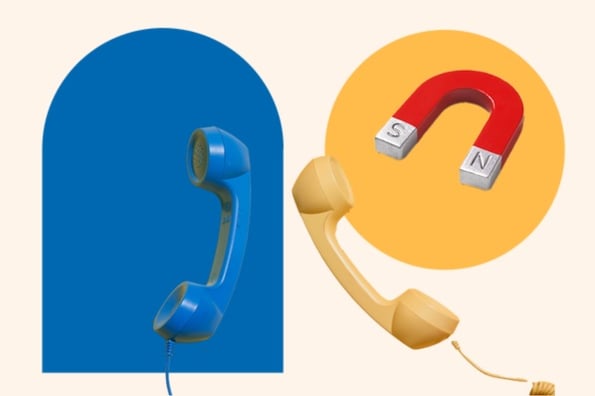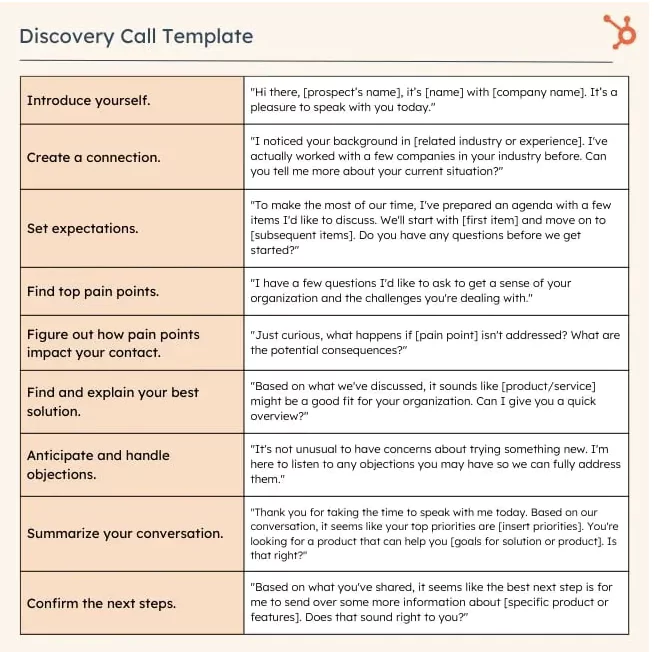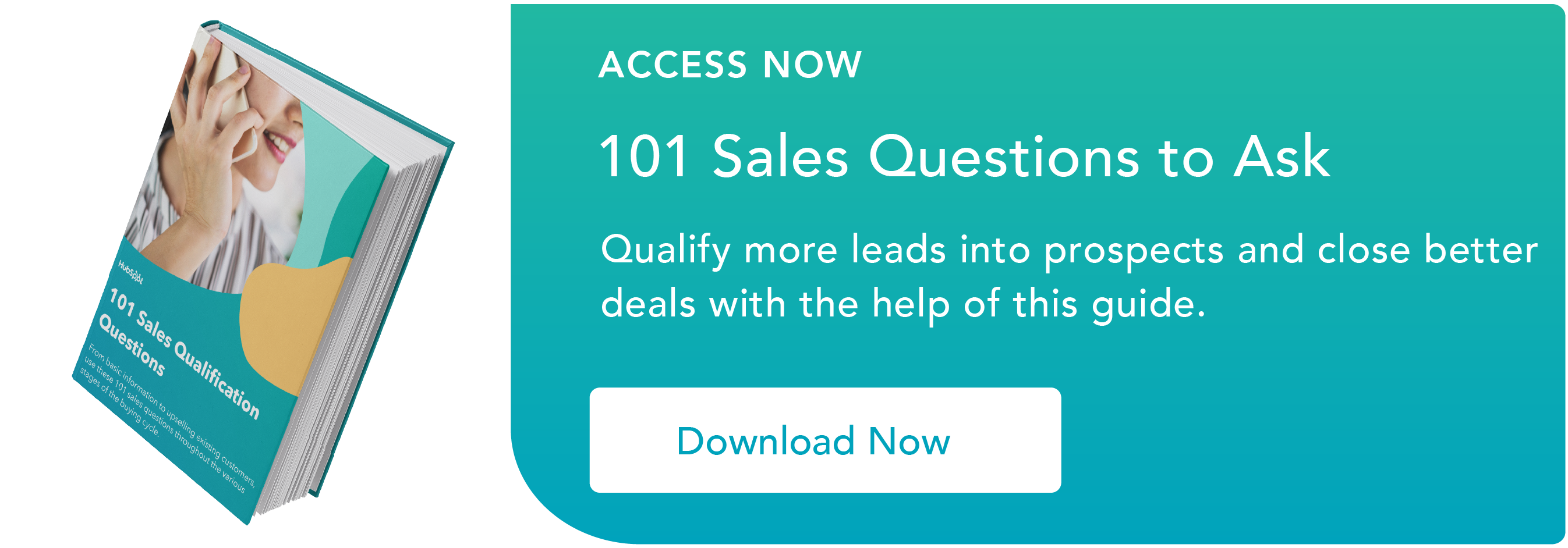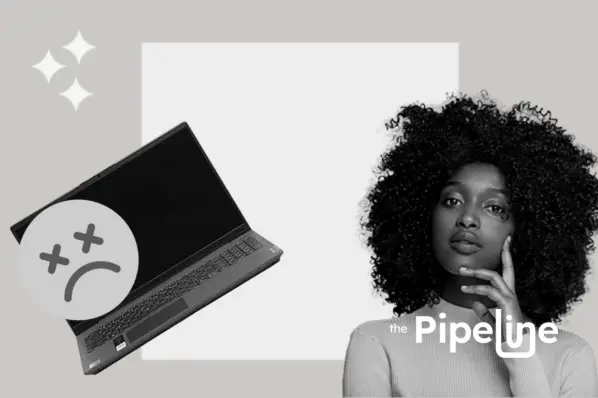Sexy as closing calls may be, they don't happen without solid discovery calls laying the groundwork. The smoothness of your sales process, the quality of your sales conversations, and ultimately, the difference between a closed-won deal and one that hits a wall can all rest on the success of your discovery.

Not all prospects are created equal — so no matter how sound your offering might be, there‘s no universal guarantee that everyone you talk to is a perfect fit. A well-structured, thoughtful discovery call gives you a sense of the size and viability of a deal — cueing you into whether the 10 to 20 hours you’re going to spend with a prospect will be worth the effort and resources.
Now, you might be thinking, “These discovery calls sure do sound important — but where on Earth can I go to learn more about them?” Lucky for you, you‘re in the right place. Here, I’ll offer more context about what discovery calls are, the best questions to ask whether your prospect is a good fit, and some handy discovery call scripts. So what are we waiting for? Let's dive in!
Table of Contents
- What is a discovery call?
- Discovery Questions
- Sales Discovery Process
- How to Run a Discovery Call
- Discovery Call Template
- Discovery Call Tips
What is a discovery call?
A discovery call is the first conversation a seller makes to a prospect after they show interest in that seller's offering. The purpose of a discovery call is to tease out a prospect's pain points, discuss goals, build rapport, and ultimately determine whether they're a good enough fit to continue moving through your sales process.
The discovery call is your tone-setter, and I mean that in a few ways. For one, it's the first opportunity you have to talk to your prospect at length — making it crucial in establishing sound rapport.
It also gives you valuable context about your prospect‘s goals, needs, interests, and pain points — giving you a roadmap for how to most effectively structure your sales efforts around your prospect’s specific circumstances.
In short, it can be the difference between establishing an authoritative relationship or spending your whole sales process playing catch up.
Admittedly, I‘ve made my fair share of shoddy, shallow discovery calls at points in my career. The result? I’ve had an equally fair share of unduly complex deals that I thought would be straightforward.
Why are discovery calls important?
Discovery calls are central to understanding any prospect‘s situation. And that makes sense — you can’t understand the nuances of what a potential buyer is dealing with if you don‘t ask them about, well … what they’re dealing with.
Luckily, in my experience, prospects are generally okay with participating in a discovery call — so long as it's not an interrogation.
Discovery calls pose some key benefits, including:
- Helping your prospect understand your business and product. These days, buyers are as empowered and well-informed as they‘ve ever been. Still, I’ve found that there‘s almost always room for them to learn more in discovery. A discovery call provides a forum for you to answer your prospect’s specific questions about your product and, in turn, gauge and capture their interest.
- Showing you’re invested in your prospect’s success. A thoughtful, well-executed discovery call shows your prospect that you understand their problems and will make a concerted, professional assessment to see if you can help them — demonstrating that you care about their success, not just their money.
- Giving you a sense of whether you can actually win their business. I've had my share of ultimately doomed deals that I wasted a lot of time and effort on — and in some cases, that stemmed from undercooked, poorly executed discovery. These kinds of calls give you an opportunity to qualify your prospect, providing the space to learn their pain points and degree of organizational influence. Discovery calls help you get a sense of whether they have a bonafide need for your offering and whether your contact will advocate for you. Incorporating a sound qualification framework like BANT (or an alternative) helps you get this done.
As you can probably tell at this point, I‘m a big discovery call guy. I sincerely believe that delivering on yours is critical to a successful sales process — so at this point, you’re probably thinking, “Oh baby, Dan! I‘m sold on this whole ’discovery call' thing! But where do I go from here? How in the gosh darn heck do I handle these calls?”
To that, I say, “Good question, reader!” Here's the answer — asking the right questions. Let's take a look at some of the questions I often incorporate into my discovery calls.
.png)
Free Guide: 101 Sales Qualification Questions
101 Questions to Ask Contacts When Qualifying, Closing, Negotiating, and Upselling.
- Budget Questions
- Business Impact Questions
- Competitor Questions
- And More!
Discovery Questions
Discovery questions are questions you ask a prospect to gauge whether or not they are a good fit for your product or service. These questions should be open-ended and focus on the prospect’s obstacles, processes, and goals as they relate to the product or service you are offering.
For context, sales discovery generally involves four parts: setting the stage, qualifying the prospect, disqualifying the prospect, and establishing next steps. You won’t be able to cover every question listed here on every call — and it might not make sense to — but I find as you go along, you should get a sense of the right questions to ask.
You‘ll notice that all of the questions I’ve listed are open-ended — that's because you want to get your prospect talking on a discovery call. If you limit a prospect to “yes” or “no” answers, you limit your ability to get as robust a picture as possible of their circumstances.
Let’s take a closer look.
Questions That Set the Stage
This is where you validate your research and learn about the customer’s situation. This gives you the proper insight you need to move forward.
1. Tell me about your company.
This seemingly simple question begins with an easy topic: The prospect’s own company. This gives them a chance to introduce themselves on their own terms, but be careful — if you ask this question too early, it might seem like you didn’t do any research at all. I generally begin by stating what I already know, then I ask this question, so they can build upon my description of their business.
2. Tell me about your role. What do you do day-to-day?
With this question, you can begin to find out more about the employee (not the business) in a more casual, low-pressure way. I don't dive too deep into the details when I ask this question. Keep things lower stakes here — and in my experience, prospects are usually excited to share.
3. What metrics are you responsible for?
Here’s where the pressure begins to mount. I find that prospects don‘t always touch on what they’re responsible for when asked the previous question. You need to ask this to uncover that information. The language here is also very important — I always use the word “metric.” You need to ask about a quantifiable measure of success. That will allow you to concretely quantify how your offering can improve that metric.
Questions That Qualify
After you’ve learned about your prospect, it’s time to identify their goals and clarify their pain points. You can use the Budget, Authority, Need, and Timeline (BANT) framework to help formulate the questions you'll be asking during your discovery call.
Learn about their problems so you can solve for the customer.
4. Tell me about your goals (financial, customer-related, operational).
In many cases, I append a timeline to this question: "Tell me about your goals for the next month/quarter/year" — adding that kind of specificity tends to produce more pointed, valuable insight. I usually choose a timeline depending on the implementation process of my product. For instance, if I was selling an enterprise-level tool that takes six months to set up, I might ask about yearly goals instead of monthly goals.
5. When do you need to achieve these goals?
While the prior question might hint at a timeline, this question explicitly asks when your prospect must achieve the goal. A yearly goal might be "To increase revenue by 5% year-over-year,“ but the cut-off date for that is in three months, just in time for the New Year. ”Yearly“ does not mean ”next year." It could be as soon as this quarter.
6. What problem are you trying to solve?
Does this question seem vague to you? That's because it is, and I have a good reason for that — that vagueness prevents you from pigeonholing a prospect into giving you a certain answer. I always want to give them a chance to bring up any problem they're facing. That way, I can get a better sense of their business challenges at a more overarching level.
7. Are you having problems in [area as it relates to the product]?
This question lets you lock in on the nuances of your prospect's pain points after the one above. I still keep things open-ended with this one, but now, I drive them toward a specific area of their business. I know this is technically a “yes or no” question — but it still prompts a prospect to think more deeply about their challenges.
8. What’s the source of that problem?
I always ask this question right after the previous one — that sequence lets me uncover key pain points or areas of friction. My prospect might not know what their problem is, but if I don‘t understand why they’re having the problem, I can't hone in on the source as something I can eliminate. Knowing the source of the problem is key to creating an irresistible sales pitch.
9. Why is it a priority today?
I‘ll occasionally skip over this question — but only if my prospect naturally reveals why their problem is a priority in the previous answer. That said, if I think asking this will give me a better sense of exactly why the problem they mention is a priority, I’ll go ahead and do it. It can provide valuable context around how urgent this problem is for your prospect.
10. Why hasn’t it been addressed before?
I find that knowing the roadblocks a prospect has faced in solving their problems can hint at their current roadblocks (or the ones they might face down the line). For instance, when a prospect cites budget as an issue with me, I know to focus on that as a qualifying factor.
11. What do you think could be a potential solution? Why?
I ask this question to find out how a prospect envisions resolving their problem — even if the answer might not include my solution. Asking this gives you a sense of where their strategic vision and priorities lie. It offers a valuable look at how they problem-solve, giving you some perspective on how to tailor your value proposition to suit how they think.
12. What would a successful outcome look like?
I ask this to get a sense of what their image of success looks like, and it's not always realistic — but it generally gives me a picture of whether my solution legitimately suits their ideal outcome. Listen without judgment here, but be sure to take note of their expectations to confirm whether you can actually help.
13. If you didn’t choose a product, do you have a plan in place to address this problem?
This question always gives me a sense of how urgently they need a solution for their challenges. If they say they don‘t have a plan in place or can’t envision solving the problem another way, then I know they're not a good-fit prospect.
Questions That Disqualify
Next, ask questions that might disqualify the prospect. Find out what you can about the decision process, from budget to scheduling.
14. What are your primary roadblocks to implementing this plan?
Even if I have an idea of the roadblocks a prospect will face, I still ask this question to get a straight answer from them. Sometimes, you need to put a prospect on the spot a bit — a frank question like this can get you some hard context on what they're facing.
15. What’s your timeline for implementation?
This question is one of the more important ones I‘ve listed here. If their timeline and my timeline aren’t compatible, I can more or less automatically disqualify them. The “T” in BANT is there for a reason — asking this question is the easiest way to reveal that context.
16. What’s the approximate budget for solving this problem?
Here‘s another frank, necessary question. You always need to know if there’s enough money for them to invest in a new product or project if you‘re going to allocate the time and resources for a sales engagement. I find that when it comes to sales, it’s never too early to talk about budget.
17. Whose budget does the funding come from?
Measure up the tone of the conversation before asking this question. It might be too probing for a prospect who’s not well acquainted with you yet. If you and the prospect are on comfortable terms, find out where exactly the money will be coming from.
18. Is the budget owner an “executive sponsor”?
An executive sponsor is a senior-level employee who’s directly involved in a project and is committed to its success. Whether that’s your prospect’s direct manager or a C-suite executive, it’s important to know whether the owner of the budget is a single person or the entire department.
Questions that Establish Next Steps
Lastly, ask questions that move the prospect along the pipeline. Provide a solution and offer next steps.
19. Who else will be involved in choosing a vendor?
This is a critical question for understanding whether your prospect is a gatekeeper, influencer, or decision-maker. Indirectly, you’ll also find out just how involved the decision-making process is.
20. Do you have written decision criteria for choosing a vendor? Who compiled these criteria?
If you’re speaking with a smaller firm, then the answer will most likely be no. But this question is important if you’re working with enterprise businesses. Try to get access to the decision criteria if possible.
21. Have you purchased a similar product before?
Knowing what your prospect has tried before will be instrumental in establishing a competitive advantage. You should be prepared to uphold your product above the competition’s even if the prospect doesn’t mention them by name.
22. Is this a competitive situation?
Who else is your prospect considering purchasing from? This question will uncover that without sounding whiny or defensive.
23. What’s the process for actually purchasing the product once you decide on it? Are there legal or procurement reviews?
If you’ve gotten to this point, you’ve probably built a high level of trust with your prospect. So you can ask right out about the purchase process without pushing them away.
24. What are potential curveballs?
While question #14 alluded to roadblocks, this question will reveal if there will be any unexpected changes that might bring the deal to a halt. Plus, if the prospect didn’t share too much when you asked about roadblocks, this question could do a better job of uncovering them.
25. How can I help make this easy?
The prospect might not have anything for you, or they might ask for additional resources and documentation. Either way, you want to give them a chance to articulate ways you can make the process easier.
26. How will this solution make your life better?
You can instill relief in your prospect by helping them envision how their work life will improve after they purchase your product. This will do a lot of work when it’s time for your prospect to present your solution to stakeholders.
27. If you implement this solution, how do you hope things will be different in one year?
Will they have more customers? Or will they have wasted less time doing menial tasks? Again, nudge them to envision how things will be better with your product on hand.
28. Can I follow up with you on mm/dd?
Close the call strongly by suggesting a date to follow up.
You’ll know that you’ve run a good discovery call if you and your prospect are able to create a written sales plan and delineate the next steps. If there’s still uncertainty when you hang up the phone, schedule another call to iron out remaining details.
Next, I'll review the sales discovery process, talk about how to run a discovery call and share a full discovery call template that you should follow for a greater chance of success.
Sales Discovery Process
In the sales discovery process, you will research your prospect, connect by phone, ask them key qualifying questions, answer any questions they have, solve their challenges, and hopefully move them along the sales pipeline.
This process is the first step in the connect phase of the sales process — and while it might revolve around teasing pressing and relevant insight out of your prospect, you can't go into it knowing absolutely nothing.
A discovery call calls for some prep work. If you approach your prospect without any context, you can‘t ask the kind of questions that will reveal the kind of information you need to thoughtfully consider whether they’re worth your time. You‘ll also run the risk of undermining your credibility with a prospect by coming off as disorganized — or you might lead them to believe that they’re just another name on a list for you.
Research the prospect and their company.
Spend as much time as you can researching and understanding your prospect’s business. Know their vertical, their challenges, and their goals. Take a look at their engagement history with your company — how did they demonstrate interest in you?
For instance, if they downloaded a guide on your website about SEO best practices, you can deduce that they might be struggling with their existing organic search demand generation infrastructure.
Having that kind of insight cues you into their goals and needs — and leveraging that perspective can inform much more thoughtfully tailored, effective discovery questions.
This sales meeting playbook can help you target your research efforts.
Gather what you’re looking for in a customer.
A discovery call‘s value goes both ways. You’re not just looking to impress a prospect — you're trying to determine whether a sales engagement with them is worth your time and effort.
That's why thoroughly understanding what you're looking for is just as important as understanding what they're looking for. Have a comprehensive understanding of your ideal customer profile and buyer personas.
Know who buys from you — along with what your solution can and can‘t offer them, their ideal price points, their buying habits, their typical pain points, and any other information that helps you understand the rationale behind your solution’s typical purchase.
All of this will help you structure the kinds of discovery questions that will reveal whether the prospect has needs and interests that align with your most productive customers.
Separate your questions into 4 segments: Staging, Qualifying, Disqualifying, and Next Steps.
.png)
An effective discovery call isn't haphazardly strewn together. It needs to have some degree of structure — arranging the call with this progression is one of the more straightforward, productive ways to get there.
Share relevant insights.
Social proof and hard data are two of the most valuable resources you can leverage during discovery. People trust industry peers and numbers more than they do a random salesperson on the other side of a call.
Having content like relevant case studies or recent research on hand to help give context and reassurance to prospects can go a long way on a discovery call. Reassurance and urgency are two of the most important elements for supporting virtually every aspect of the sales process — and discovery calls are no exception.
Showing that your offering has helped similar businesses or pointing to broader industry trends that your solution suits particularly well can help reveal business needs or pain points they might not have considered and establish that your offering can accommodate them.
Be ready to connect your solution to the prospect’s goals.
Discovery calls are primarily related to qualification, but that‘s not where their utility ends — they also provide an excellent forum for hard selling your solution. They allow you to introduce the ways your solution can suit your prospect’s needs and interests.
That‘s why you need to have a sense of a prospect’s goals — and that generally comes from conducting thorough research ahead of the call and practicing active listening throughout it.
If you conduct your call right, your prospect may very well mention their goals and pain points explicitly — but they'll also allude to more “under the surface” ones they might not have considered.
Regardless of what the insight you get out of them might be, find a way to align your solution with it. Connect what you do with what they need — briefly speak to the benefits they can expect to see.
Be careful though, you‘re not closing on this call, so don’t get too caught up — that can read as overbearing or aggressive. Check out these sales pitch examples if you’re looking for inspiration.
How to Run a Discovery Call
%20CAU%20One%20Off%20Emails/screenshot-2024-03-25-at-35554-pm-6601d6d17fece.webp)
1. Research your prospect’s business ahead of time.
I mentioned it earlier, but I'll say it again — spend as much time as you can researching and understanding your prospect’s business. In my experience, under-preparing for a discovery call is the easiest way to simultaneously undermine your ability to ultimately appeal to a prospect and wind up wasting your time on a deal that goes nowhere.
A discovery call is an invaluable opportunity — you get the chance to convey value towards the beginning of the sales process and gauge the viability of a potential sales engagement before you invest extensive time and resources in it.
If you don‘t do your research, you’re selling yourself extremely short.
2. Create an agenda and send it to your prospect.
Every sales meeting needs structure, direction, and clarity — and discovery calls are no exception. They may seem lower-stakes because they occur towards the start of the sales process, but in my experience, that's the worst possible mindset to approach them with.
I‘d go so far as to say that discovery calls have some of the highest stakes of any sales conversation because they decide where the deal will go. So you need to establish a clear picture of what’s going to happen on the call.
Doing so will help bolster your authority, let prospects know that you value their time, and if things don't pan out, give you a clearer frame of reference for where you have room for improvement.
Send your agenda to your prospect ahead of time, and give them the flexibility to add any more items they see necessary — that will ensure you're covering everything they want to talk about.
3. Set a time and date that works for both of you.
When you send the agenda, set a time and date that works for both parties. Ask your prospect how much time they’ll have. If they’d prefer to meet for 30 minutes instead of an hour, take that into account.
Depending on their flexibility, you might even be able to do a product demo during the discovery call. Be careful with this approach: If you demo the product too early, you might forget to focus on the prospects’ needs and challenges.
4. Open the call conversationally.
I find that discovery calls can be a little awkward for salespeople and prospects, alike — so always keep things light and approachable at the start. Open it up with some easy conversation.
Ask how their day or week has been, or what they did over the holidays, and as you go into the following steps, be sure to keep the tone conversational. This isn’t an interview — it’s a way to get to know each other better.
5. Set the stage.
It’s time to use the discovery questions above. These questions are a great place to start:
- Tell me about your company.
- Tell me about your role. What do you do day-to-day?
- What metrics are you responsible for?
You can skip the last question if they share their metrics of success when they describe their day-to-day work.
6. Qualify the prospect.
Just by the previous questions alone, you’ve probably gotten a good idea of whether your product can help. Further qualify the prospect by asking at least three of the following questions:
- Tell me about your goals (financial, customer-related, operational).
- When do you need to achieve these goals?
- What problem are you trying to solve?
- Are you having problems in [area as relates to the product]?
- What’s the source of that problem?
- Why is it a priority today?
- Why hasn’t it been addressed before?
- What do you think could be a potential solution? Why?
- What would a successful outcome look like?
- If you didn’t choose a product, do you have a plan in place to address this problem?
Remember to keep the tone conversational. These questions should flow naturally.
7. Ask disqualifying questions.
It’s just as important to disqualify the prospect as it is to qualify them. That way, you don’t waste your time. Ask the following questions:
- What are your primary roadblocks to implementing this plan?
- What’s your timeline for implementation?
- What’s the approximate budget for solving this problem?
- Whose budget does the funding come from?
- Is the budget owner an “executive sponsor”?
Feel free to make the tone less conversational here and get a little more firm. You want the prospect to think carefully through their answers and not just throw out the first thing that comes to mind.
8. Establish next steps.
Last, set up next steps. There should be no question about what the prospect (or you) should do to move the deal forward. Be sure to ask:
- Who else will be involved in choosing a vendor?
- Do you have written decision criteria for choosing a vendor? Who compiled these criteria?
- Have you purchased a similar product before?
- Is this a competitive situation?
- What’s the process for actually purchasing the product once you decide on it? Are there legal or procurement reviews?
- What are potential curveballs?
- How can I help make this easy?
- How will this solution make your life better?
- If you implement this solution, how do you hope things are different in one year?
- Can I follow up with you on mm/dd?
Discovery Call Template

You‘ve done your research, have your questions ready, and are set to begin your first discovery call. But if you’re new to sales or are trying to meet aggressive goals, it can be tough to keep conversations casual.
If you need some inspiration to keep the conversation flowing, it can help to have a discovery call template with some quick discovery call scripts, like the ones below.
These suggestions are organized in chronological order, so you can create a custom template from the choices in each section, or pick and choose from the sections that are most useful for you. Doing so can help you structure a thoughtfully constructed discovery call script to reference when making your calls.
Introduce yourself.
- “Hi there, [prospect’s name], it’s [name] with [company name]. It’s a pleasure to speak with you today. I’m hoping to learn more about your business and how we might be able to help.”
- “Hello [prospect’s name], I‘m [name] with [company name]. I’ve been doing some research on [your company] and I’m impressed with what I’ve seen so far. I’d like to learn more about [name a specific goal, challenge, or opportunity] to see if there is a way we can work together.”
- “Good [morning/afternoon] [prospect’s name], it’s [name] with [company name]. I was initially referred to you by [referral name]. They mentioned you're looking to [insert potential pain point]. I’d love to learn more about your situation and see if we can help.”
- “Hey [prospect’s name], it's [name] from [company name]. I recently noticed [something positive about the company/compliment]. I wanted to connect with you to see if there might be a way we could work together.”
Create a connection.
- “Just so I can make sure I understand your needs, could you tell me a little about what your company has been focusing on lately?”
- “What challenges are you currently facing with [related pain point]?”
- “I noticed your background in [related industry or experience]. I've actually worked with a few companies in your industry before. Can you tell me more about your current situation?”
If these starters feel too fast or formal for your prospect, check out this list of conversation starters.
Set expectations.
- “Just a heads-up, our call shouldn‘t take more than [specific time you have in mind]. I’m hoping to get a better understanding of your business and the challenges you're facing. Does that sound good to you?”
- “I'm looking forward to our call today. My goal is to get a better understanding of your current situation so that I can see how we may be able to help. How does this fit with your objectives for the call?”
- “To make the most of our time, I‘ve prepared an agenda with a few items I’d like to discuss. We'll start with [first item] and move on to [subsequent items]. Do you have any questions before we get started?”
- “By the end of our call today, I hope to have a clear understanding of your business and goals and share how we could help. Then the next step would be for us to schedule another call to dive deeper. Does that sound like a good plan?”
Find top pain points.
- “I have a few questions I‘d like to ask to get a sense of your organization and the challenges you’re dealing with.”
- “I saw on your website that you recently posted a [blog/article] about [topic related to pain point]. Can you tell me more about the situation that led you to publish that post?”
- “I've been talking with other companies in your industry and it seems like [pain point] is a common challenge. Is this something your team is experiencing too?”
- “I know it's been a tough time for businesses in your industry. What challenges have [your organization] faced over the past few months?”
In addition to the qualifying questions above, creative open-ended questions are a great way to surface pain points.
Figure out how pain points impact your contact.
- “Thank you for telling me about what your organization is dealing with right now. How do you think these challenges are impacting your role?”
- “I'd like to get a better understanding of [pain point] you mentioned. How does [pain point] impact your business and goals?”
- “Just curious, what happens if [pain point] isn't addressed? What are the potential consequences?”
- “How do those challenges impact other departments or stakeholders? Would it make sense to collaborate to solve [pain point]?”
Find and explain your best solution.
- “Based on what we've discussed, it sounds like [product/service] might be a good fit for your organization. Can I give you a quick overview?”
- “I've been thinking about how we might be able to help solve {pain point]. Our [product/service] is designed to [brief value proposition]. Would you like to hear more about it?”
- “I've been through similar challenges with other clients in the past. We were able to help them by [brief case study or testimonial]. Does this sound like it would work for you?”
- “It seems we both feel [related topic] is important, and our conclusions on [pain point] align with that. Do you think [product/service] could improve your situation?”
- “Can you walk me through the specific needs of [project], so I can share how we can customize [product/service] to meet those needs?”
Anticipate and handle objections.
- “It sounds like you may not be ready to put this solution in place. Let's address any concerns so we can find a way to work together.”
- “I've found that some clients are hesitant to move forward because of [related objection]. Do you want to share your thoughts on this?”
- “It‘s not unusual to have concerns about trying something new. I’m here to listen to any objections you may have so we can fully address them.”
- “Some people may not be ready to use a new resource because of [related objection]. We‘ve gotten results for other clients with similar challenges. I’m here to work with you to develop a solution that meets your specific needs.”
This guide to objection handling is essential if objections are a deciding factor in the outcomes of your discovery calls.
Summarize your conversation.
- “Thank you for taking the time to speak with me today. Based on our conversation, it seems like your top priorities are [insert priorities]. You're looking for a product that can help you [goals for solution or product]. Is that right?”
- “To summarize, it sounds like you're facing [insert challenges] and you want a solution that can help you [insert priorities]. Does that sound right to you?”
- “To recap, you're looking for a tool that can help you with [insert priorities]. And the features that are most important are [insert features]. Is that a good summary?”
It's also a good idea to take notes on your summary so that you can include specific details in your follow-up email.
Confirm the next steps.
- “To pin down the next steps, I‘d like to learn more about [questions you didn’t get to ask during the conversation].” After this intro, follow up with Qualifying Questions, Disqualifying Questions, or Questions that Establish Next Steps.
- “Thanks again for your time today. Based on what you've shared, it seems like the best next step is for me to send over some more information about [specific product or features]. Does that sound right to you?”
- “To get started, we‘ll need to complete some specific steps. First, I’ll [specific action, like send you a proposal], and then we can schedule a call to review it. How does that sound to you?”
- “It sounds like we agree that [product] can help solve [pain point]. What would be your ideal next steps to move forward?”
Discovery Call Tips
1. Prioritize qualification over process-based questions.
Focus on whether the prospect is ready for your product before figuring out how to implement it. For example, a legal or procurement process isn’t a roadblock to a sale, but a lack of a business plan is.
Get the big-ticket items out of the way first. For example, establishing a pain point or goal and talking through potential choices. Then you can move on to the details of the deal.
2. Confirm understanding before moving to the next question.
Clear communication will make the difference in whether you close a sale. It can be tempting to jump to the questions that will bring you closer to close, but that could lead to missed opportunities.
Let your prospect share any insights that could give you context for their business needs and goals. “Why” questions can help you uncover the root of a prospect's challenges. They can also help you understand what has motivated them to find a solution and how urgent the problem is.
3. Keep asking questions until you fully understand your prospect.
Ideally, a discovery call will either clearly surface a sales opportunity or definitively disqualify a prospect. You should come out of your calls with an understanding of your prospect’s needs and how you can help solve them.
4. Utilize active listening and open-ended questions.
Shane McEvoy, Founder of Flycast Media, says, "Over the years, I‘ve honed a couple of secret moves for discovery calls that really pack a punch. First off, active listening isn’t just a buzzword in my playbook — it‘s the golden key. Locking into every word a prospect says lets me dive into understanding the exact pain points they’re wrestling with. It helps me gather the intel needed to tailor a pitch-perfect solution that resonates on a personal level.
"It‘s how I turn lukewarm leads into raving, loyal clients. Then, there’s the art of the open-ended question — my go-to tool for getting prospects to spill the beans. These are the kinds that invite a story, drawing out the juicy details you can‘t get with a simple yes or no. It’s like opening a door and inviting them to walk me through into their world, revealing the hidden gems of what they really need.
“This approach, done right, can skyrocket conversion rates and increase client satisfaction tremendously. It proves that a dash of curiosity and a genuine desire to connect can transform a run-of-the-mill call into a game-changing conversation.”
5. Add value in small and subtle ways.
Always add value to each discovery call. This may mean offering recommendations or simple ways to help. And be sure to personalize so your value-add doesn't seem self-serving.
If you leave the prospect with a positive impression, they are more likely to reach out when they become sales-ready (if they aren’t currently).
6. Set a positive tone with transparency.
According to Lilia Tovbin, Founder and CEO of BigMailer.io, transparency is central to productive discovery calls. According to her, you need to "[be] upfront about your intentions and the purpose behind the discovery call.
"From our experience, being transparent right from the start sets a positive tone and promotes trust with the prospect. This helps align our expectations and ensures that both parties are on the same page, which is crucial for a fruitful discussion.
“I recall a recent discovery call with an e-commerce client. Right from the outset, we transparently mentioned that we wanted to explore how our platform could provide solutions that fit their needs. This immediately created a favorable ambiance for the conversation, as the client appreciated our honesty. It also encouraged them to openly share their challenges and eventually allowed us to be part of achieving their goals.”
7. Personalize your strategy with empathy and research.
Aseem Jha, Founder and Head of Customer Delivery at Legal Consulting Pro, says, "Imagine stepping into a discovery call armed not just with a pitch, but with a personalized strategy that resonates deeply with your prospect. As a seasoned sales leader, I‘ve learned that the secret lies in meticulous preparation coupled with genuine empathy. Before the call, delve into your prospect’s world — understand their industry, challenges, and aspirations.
"During the conversation, prioritize building a rapport that goes beyond the transactional. Share insights gleaned from your research, but more importantly, listen intently to their story. It's in these moments of active listening that you uncover the nuggets of information that can transform the trajectory of your sales pitch.
“I‘ve found that by focusing on understanding rather than simply selling, I’ve not only closed deals but forged lasting partnerships. This approach isn‘t just a strategy; it’s a mindset shift that has consistently delivered results in my sales journey.”
8. Highlight consequences to create urgency.
Lev Tretyakov, CEO and Sales Director of Fortador, "I explain what would happen if they do not solve the problem. We often focus on discussing what would happen if they solve the problem and forget to address what would happen if they don't, which is the key to creating urgency. Ask second and third-layer questions like, ‘How will this impact your business’s revenue, cost, and risk?' This week, I was talking with a potential client who was concerned about the efficiency of their cleaning solutions.
"He felt their cleaning was not up to par. Moving beyond the immediate benefits of our steam cleaners, I steered the conversation to discuss what would happen if they did not upgrade. They would incur more maintenance costs, lower customer satisfaction, and risk of shutdown due to noncompliance with health regulations.
“This highlighted the benefits of our products but created a sense of urgency and necessity. People appreciate it more when you come off as a consultant. So, make a real human conversation beyond checking off a list of questions.”
9. Align value with your client's goals.
Kristy Galea, Director Of Sales at Cadence SEO, says, “When conducting discovery calls, I begin the conversation around the client's goals and build the call around how value can be attributed to those goals and benchmarks — overall, discussing value and educating the client on how they can solve the issues promptly. Their needs are the most important at all times.”
10. Approach calls with a learning mindset.
Chris Riley, Founder of Cuppa AI, says, "My top tip for conducting effective discovery calls is to go in with a learning mindset, not a selling one. Ask open-ended questions to deeply understand your prospect‘s key challenges and priorities. Listen for what’s not being said, read between the lines, and probe further.
“Too often, reps go into calls with a rigid agenda, talking over the prospect. An effective discovery call should be a conversation, not a pitch. Let the prospect‘s challenges and needs guide the discussion. The more you listen, the more they’ll open up. And the more they open up, the better equipped you'll be to provide real value. An insightful discovery call builds trust and sets the foundation for a long, successful partnership.”
11. Follow up promptly and thoroughly
Samantha Odo, Real Estate Sales Representative and Montreal Division Manager at Precondo, says, "It‘s crucial to establish a clear agenda for the call. Let the client know what topics you’ll be covering and what they can expect from the conversation. This helps set expectations and keeps the call on track.
"Always follow up on any action items or next steps discussed during the call. Whether it‘s sending additional information, scheduling a follow-up meeting, or providing answers to specific questions, make sure you’re proactive in moving the conversation forward.
“These strategies have been instrumental in my success as a real estate sales representative. By setting clear agendas, asking open-ended questions, actively listening, and following up diligently, I‘ve been able to build strong relationships with clients and ultimately close more deals. Give them a try, and I’m confident you'll see positive results too.”
Great Discovery Calls Will Help You Close More Deals
Investing time and energy in creating a great discovery call will let you know for sure whether a prospect is a good or poor fit for the product. This will help you focus your time on the prospects who are more likely to close. This can help you exceed quota and become a standout performer in your team.
Editor's note: This post was originally published in October 2015 and has been updated for comprehensiveness.
![Free Download: 101 Sales Qualification Questions [Access Now]](https://no-cache.hubspot.com/cta/default/53/e97d6603-b40e-4085-ad55-0074b7351ead.png)

![How to Use BANT to Qualify Prospects in 2024 [Expert Tips]](https://blog.hubspot.com/hubfs/bant-questions-6606f7b6c0d9e.webp)


![21 Signs Your Buyer Is a Poor Fit [Sales Process Checklist], According to HubSpot's Former Sales Director](https://blog.hubspot.com/hubfs/Bad%20fit%20checklist.jpg)





![What a Client Intake Form Is & What It Should Look Like [Template]](https://blog.hubspot.com/hubfs/CLIENT%20INTAKE%20FORM%20%281%29.jpg)